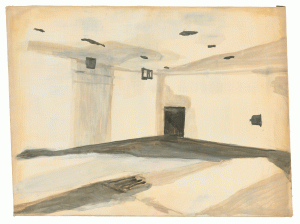« Reviews
Luc Tuymans

Luc Tuymans, Gaskamer (Gas Chamber) 1986, oil on canvas, 24 x 32 1/2 in., The Over Holland Collection. In honor of Caryl Chessman, © Luc Tuymans, photo: Peter Cox. Courtesy The Over Holland Collection
San Francisco Museum of Modern Art
Curated by Madeleine Grynsztejn & Helen Molesworth
By Franklin Meléndez
Luminous in its flatness, the Luc Tuymans mid-career survey at SFMoMA brings together an impressive array of works, expertly selected by co-curators Madeleine Grynsztejn and Helen Molesworth from his prolific output of over 500 paintings. The second leg of the tour, which debuted at the Wexner Center last fall, is also its sole West Coast engagement. The show unfolds in no-nonsense chronological order; its only ostentatious flourish: re-creating the original installations of key bodies of work from the artist’s career, including The Architect, the groundbreaking Holocaust series which sealed his reputation as a contemporary master, and most recently, Proper, his paintings on post-9/11 paranoia and regressive politics (perhaps best summed up by the close-cropped grimace of Condoleeza Rice in 2005’s Secretary of State). Like a series of declarative sentences, this approach verges on the taxonomical, and the overall effect is not unlike a Robbe-Grillet description: stark, repetitive and ultimately enigmatic. And therein lies the subtle brilliance of the installation, in simply mirroring Tuymans’ own approach which eschews any facile teleology, opting instead for a series of disparate objects in loose arrangement that never quite coalesce into a cohesive narrative-and that is the point. Of course, this requires a great deal on the part of the viewer, who is left to make sense of a series of individual encounters that are shaped by seemingly miniscule factors: the angle of light, the length of perusal, the flickering of trivial details that can suddenly yield moments of insight and poignancy. It is an uncertain journey, disorienting and at times frustrating. Patience is key and persistence pays off-the trick perhaps lies in accumulating multiple impressions that build up like layers of paint. Through this process, subtle permutations are revealed, and the secret of Tuymans’ alchemy momentarily unlocked. For instance, there is 1990’s Body, based on his sister’s doll, with its violent truncation, primitive brushstrokes and cracked surface, which is the artist’s first attempt at achieving the faux patina he terms “authentic falsification.” There are a series of relatively early works on cardboard, whose corrugated surface subtly disrupts the brushwork; and, of course, the iconic, Gas Chamber (1986), deliberately framed as a slightly warped trapezoid that becomes increasingly affecting on extended viewing. The distortion reasserts the painting’s status as a placeholder for an impossible history, but it also offers an apt commentary on the lasting viability of the monument. Ultimately, this is less about chronicling recent historical ruptures, than capturing them in their becoming: a hopelessly muddled and incomplete process that inheres in the trivial. It is a strange and unsettling vocation-at which Tuymans proves masterful.
(February 6 - May 2, 2010)
Franklin Meléndez is an art critic based in San Francisco.
Filed Under: Reviews


































